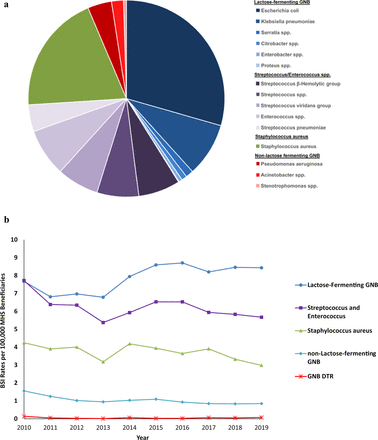
Click to Enlarge: Bacteria associated with bloodstream infections (BSI). (a) Distribution of total bacteria; (b) BSI rate per 100 000 Military Health System (MHS) beneficiaries per year by classification group. There were no DTR Gram-positive bacteria. DTR, difficult-to-treat resistance; GNB, Gram-negative bacilli. Source: BMJ Open
BETHESDA, MD — The mortality burden associated with bacterial bloodstream infections is substantial in the MHS, with about 1 in 4 patients dying within 1 year of a bacterial bloodstream infection diagnosis, according to a recent study.
The retrospective cohort study published in BMJ Open examined the demographics, causative pathogens, hospitalization, mortality and antimicrobial resistance of bacterial bloodstream infections (BSIs) among beneficiaries in the Military Health System (MHS), with 10-year longitudinal follow-up.1
The study authors are affiliated with the National Institute of Allergy and Infectious Diseases (NIAID) of the National Institutes of Health (NIH), Uniformed Services University of the Health Sciences and Henry M. Jackson Foundation for the Advancement of Military Medicine Inc., each in Bethesda, MD; Indian Health Services in Rockville, MD; and Brooke Army Medical Center in Fort Sam Houston, TX, among others.
In this study, the investigators collected demographic data and diagnosis codes preceding BSI episodes and during hospitalizations. The data were gathered from the MHS Data Repository and combined with microbiological data from the Defense Centers for Public Health-Portsmouth.
The study included 12,748 MHS beneficiaries who were diagnosed with 15,357 BSIs from 2010 to 2019. Nearly half (48.8%) of the patients, or 6,216 individuals, were 65 or older. The inpatient admission data identified acute clinical diagnoses, intensive care unit (ICU) admission and mortality. BSI pathogens were evaluated for antimicrobial resistance, including difficult-to-treat resistance. The research team also assessed crude mortality trends.
“We wanted to describe bacterial bloodstream infection patterns in a global healthcare system where universal care is provided to all active duty and retired service members and their families,” lead author Alexander Vostal, MD, told U.S. Medicine.
“The burden of mortality from BSI was substantial in the U.S. Military Health System, with approximately 1 in 4 individuals dying within 1 year of a BSI diagnosis. Despite reports of increases in bacterial pathogens with antimicrobial resistance, first-line antimicrobial therapy remained available for 99.7% of the BSI pathogens in this cohort,” said Vostal, who is a lieutenant commander in the U.S. Public Health Service and research officer/clinical fellow in the Medical Virology Section, Laboratory of Infectious Diseases at NIAID.
The analysis identified 15,357 BSI episodes in 12,748 patients, with 83.7% of episodes having one or more comorbidities. About 29% of episodes with hospitalization required ICU admission, and approximately 34% had concurrent urinary tract infections. Fifty-three percent of pathogens were Gram-positive bacteria, and 47% were Gram-negative bacilli.
The study found that inpatient mortality was 4.4%, and it reached 23.4% at one year. Also, 0.5% of deaths (16 of 2,977) were associated with difficult-to-treat resistance Gram-negative bacilli.
Among more than 8 million individuals receiving care each year in the MHS, the researchers determined that annual rates of overall BSI, methicillin-resistant Staphylococcus aureus, vancomycin-resistant Enterococcus spp and difficult-to-treat resistance Gram-negative bacilli BSI were 18.9, 1.30, 0.25 and 0.05 per 100,000 beneficiaries, respectively. Annual mortality didn’t significantly increase over the decade for any pathogen and decreased by approximately 2% for overall BSI and approximately 3% for lactose-fermenting Gram-negative bacilli BSI, the investigators reported.
“Compared to prior studies that tend to be cross-sectional, single-center studies with limited follow-up, our longitudinal cohort allowed us track mortality up to one year after BSI, where we observed an approximately five-fold increase in mortality after individuals are discharged from their hospital admission,” Vostal explained. “This comprehensive data set will allow us to complete additional analysis matching individuals with similar demographics and comorbid conditions with either an antibiotic “susceptible” or “resistant” infection. We can then utilize this analysis to identify risk factors and attributable outcomes from various BSI pathogens.”
Considering that almost all BSI pathogens in this cohort were susceptible to first-line antibiotic therapy, further research into improving morbidity and mortality from bacterial infections should maintain a proportional focus on infection outcomes from antibiotic “susceptible” compared to antibiotic “resistant” pathogens, Vostal explained.
Additional Morbidity, Mortality
For healthcare professionals who are treating veterans and military personnel with BSIs, Vostal pointed out that individuals who develop BSIs are not only at extremely high risk of mortality in the inpatient setting, but there is also additional morbidity and mortality risks, possibly related to the clinicopathology of BSI, that arise after hospital discharge.
“This observation illustrates the importance of allocating appropriate resources for comprehensive post-discharge follow-up care,” Vostal said. “Additionally, future research studies should be tailored to identify and mitigate the risks beyond an inpatient stay for acute BSI.”
The investigators suggested that improvements in BSI survival might be influenced by focusing on prevention, early detection, prompt antibiotics and other novel therapies not dependent on in vitro activity.
A major strength of this study is the universal care offered by the MHS, which reduced the potential for differences in outcomes that arise from healthcare system disparities. Also, the MHS data are more uniform and complete, which allowed for longitudinal assessments over a 10-year period, including mortality, according to the study.
Vostal noted this study was possible because of coordination between multiple federal agencies. The connection between the MHS and NIH is an important link to share research and data resources that can improve clinical outcomes for patients, he said.
- Vostal AC, Grance M, Powers JH 3rd, Kadri SS, et. Al. Demographics, epidemiology, mortality and difficult-to-treat resistance patterns of bacterial bloodstream infections in the global US Military Health System from 2010 to 2019: a retrospective cohort study. BMJ Open. 2025 Mar 3;15(3):e094861. doi: 10.1136/bmjopen-2024-094861. PMID: 40032367; PMCID: PMC11877242.

